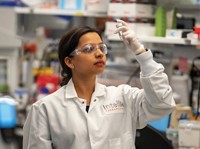Advertisement
Grab your lab coat. Let's get started
Welcome!
Welcome!
Create an account below to get 6 C&EN articles per month, receive newsletters and more - all free.
It seems this is your first time logging in online. Please enter the following information to continue.
As an ACS member you automatically get access to this site. All we need is few more details to create your reading experience.
Not you? Sign in with a different account.
Not you? Sign in with a different account.
ERROR 1
ERROR 1
ERROR 2
ERROR 2
ERROR 2
ERROR 2
ERROR 2
Password and Confirm password must match.
If you have an ACS member number, please enter it here so we can link this account to your membership. (optional)
ERROR 2
ACS values your privacy. By submitting your information, you are gaining access to C&EN and subscribing to our weekly newsletter. We use the information you provide to make your reading experience better, and we will never sell your data to third party members.
Drug Discovery
Drugmakers tackle hearing loss
Decibel and other start-ups see opportunity in growing epidemic
by Lisa M. Jarvis
March 14, 2016
| A version of this story appeared in
Volume 94, Issue 11
Not long ago, it wouldn’t have been unusual to find Third Rock Ventures founder Kevin Starr in his office at 6 AM with music blaring. Colleagues prepping for the day would have to ask him to turn it down. Not anymore. “I keep the music at a whisper level now,” Starr says. These days, he is acutely aware of the noise level inside each flight he takes. He has even taken to plugging his ears when an ambulance screams by.
What’s changed? Starr is now the interim chief executive officer of Decibel Therapeutics, launched in October to develop treatments for hearing disorders. Three years of learning about the inner workings of the ear and the growing epidemic of hearing loss prompted the venture capitalist to be smarter about protecting his own hearing. “It’s changed my life,” he says.
Decibel is the latest in a crop of biotech firms trying to find solutions to common hearing disorders. Most initial efforts are focused on preventing or repairing damage to the inner ear, where sound is perceived. A handful of firms are going after targets in the brain, where sound is processed. The loftiest efforts seek to restore hearing by regenerating hair cells, the tuftlike projections in the inner ear’s cochlea that are responsible for turning mechanical signals—sound waves—into electrical signals that are interpreted by the brain.
Those firms are tapping into a potentially huge market. According to the World Health Organization, more than 360 million people around the globe have disabling hearing loss. Yet no drugs exist to prevent or treat hearing disorders, so devices are the only option for people with a hearing problem—whether it’s age-related loss, the persistent ringing in the ear known as tinnitus, or severe loss caused by genetic or other factors. But hearing aids don’t always help, and cochlear implants for severe loss have limitations.
For Third Rock, those statistics “jumped off the page,” Starr says. “It could be one of the last major untapped areas.” Third Rock, which cultivates science internally before launching a company, spent more than three years and upward of $3.5 million to probe whether the scientific landscape is ripe for developing hearing loss treatments.
That effort convinced the venture team that hearing problems had become tractable and prompted them to formally launch Decibel. “It became very apparent that we were at a tipping point where we could change the approach and could make a difference for patients,” Starr says.
Given the enormity of the problem—and the potential windfall for successful drugs—Third Rock has made a major investment in Decibel. The company launched with $52 million in its first round of financing and already has about a dozen employees. The goal, Starr says, is to have 40 people on staff by the end of this year.
Those scientists are not only working on drug design; they are also focused on better ways to deliver drugs to the inner ear and on developing a more complete understanding of the source of hearing disorders. “We think this is something that needs a scale and size to really address the problem in a major way,” Starr says. “This is not something you can limp into.”
Among Decibel’s first projects is the development of drugs that can prevent hearing loss in children who take powerful antibiotics called aminoglycosides. Used to treat kids with cancer and combat infection in people with cystic fibrosis, aminoglycosides can irreversibly damage the inner ear.
At least two other firms are planning studies in drug-induced hearing loss. Otonomy expects to start a Phase I trial of OTO-104, a sustained-release formulation of the steroid dexamethasone, in the second half of the year in children and adults undergoing chemotherapy. The treatment uses the same delivery technology as Otiprio, a recently approved Otonomy antibiotic that is administered when children receive ear tubes to prevent infection.
And the Seattle-based start-up Oricula Therapeutics recently secured government funding to support the development of ORC-13661, a small molecule that has been shown to protect hearing in rats given the aminoglycoside amikacin. According to CEO Malcolm Gleser, Oricula expects to have collected enough data to ask for Food & Drug Administration permission to begin human studies of the drug in the fall of 2017.
Decibel and other companies are also trying to tackle tinnitus, the phenomenon of hearing a ringing or buzzing sound when none exists. According to the Department of Defense Hearing Center of Excellence, some 16 million Americans have sought treatment for tinnitus.
So far, results for firms chasing tinnitus have been mixed. In October, Autifony Therapeutics stopped enrolling patients in its Phase II study of the Kv3 voltage-gated potassium channel modulator AUT00063 as a tinnitus treatment after an early analysis of the data showed the drug wasn’t effective.
Autifony, which is continuing to develop AUT00063 for age-related hearing loss, declined to comment on whether any lessons emerged about designing drugs or clinical studies for tinnitus. The biotech says it is awaiting final data, which should come in the next few months, before drawing any conclusions about why the drug failed.
Researchers are now awaiting results from two Phase III studies of AM-101, Auris Medical’s N-methyl-
The toughest challenge is restoring hearing in people with severe loss. Currently, Novartis’s CGF166, a gene therapy aimed at regenerating hair cells, is the only treatment in the pipeline with the potential to restore function in the inner ear.
Jeffrey Bricker was one of a handful of people to receive the gene therapy before enrollment was halted earlier this year. Bricker, whose hearing started deteriorating when he was 12, wasn’t expecting a miracle. But at 58 and with just 5% of his hearing left, he hoped the therapy would regenerate enough hair cells to enable him to get more out of hearing aids.
So far, the gene therapy has fallen short of Bricker’s goal. University of Kansas doctors performed surgery to deliver the drug deep into his right ear in May 2015. Although he has brief bursts of improved hearing, they are fleeting.
“Every now and then, some of these nerve hairs ‘touch down,’ as I call it, and hearing is much better,” Bricker says. But the improvement, which he likens to plugging in an amplifier and getting a blast of sound, only lasts a few hours.
In January, Novartis paused enrollment in the CGF166 study after an interim look at safety data. “We will be assessing these data and continuing to monitor patients currently enrolled in the trial over the next several months,” the company says.
Setbacks for Novartis’s gene therapy and other treatments in the hearing disorder drug pipeline underscore the challenges of a disease with no approved therapies.
Starr contends that Decibel can overcome those hurdles with good translational science. In tandem with designing drugs, the company is trying to capture better information about how and where hearing problems manifest themselves.
To that end, the firm is trying to convince specialists to use more complex tests that could provide critical information about the anatomical drivers of hearing disorders. Right now, a patient who walks into a specialist’s office is given a “threshold” test, which uses pitch and volume to measure the degree of loss. The test doesn’t tell the doctor, for example, whether hearing is impaired because of damaged hair cells or because of a problem in how sound signals are processed in the brain.
One component of Decibel’s strategy is to build a registry of people tested with auditory brainstem response, which uses an electrode-containing earbud to more precisely pinpoint the source of the hearing loss.
That information could lead to better diagnoses, more sophisticated trials and, ultimately, better drugs.




Join the conversation
Contact the reporter
Submit a Letter to the Editor for publication
Engage with us on Twitter